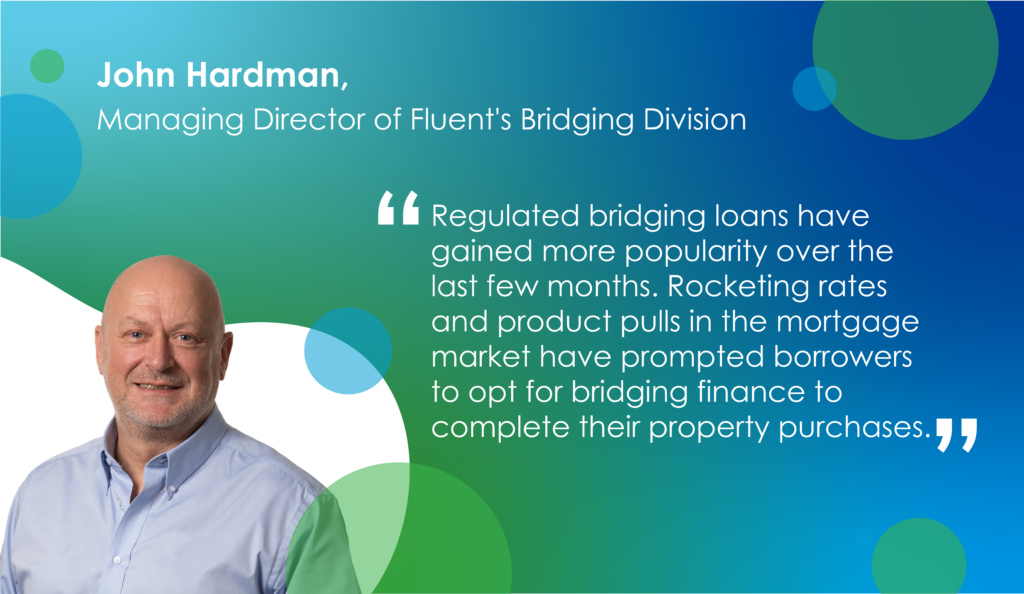Our thoughts on the bridging sector so far: More of the same in the final quarter

The last 12 months have been something of a turning point for the UK property market. Following a decade of historically low rates and relatively modest house prices, we saw lots of change last year. In just 12 months, interest rates surged by more than 5 percentage points, mortgage rates doubled and there was a notable decrease in demand for property purchases.
But the question is how much of a knock-on effect have these factors had on the bridging sector and how is the market performing?
As we enter the final quarter of 2023, we caught up with Fluent’s Bridging Director, John Hardman, to get his thoughts on the state of the bridging sector so far.
Do you think there has been a change in terms of demand for bridging finance?
Regulated bridging loans have gained more popularity over the last few months as an alternative to longer term funding. This is down to the fact that rocketing rates and product pulls in the mainstream mortgage market have prompted an increasing number of borrowers to opt for bridging finance to complete their property purchases. That said, I think the bridging market has adapted well to the economic storm and has proven to be resilient this year.
Meanwhile, flexibility and speed have long been the bedrock of the short-term lending industry. This, and how quickly you can complete compared to traditional financing options, will always be key factors as to why people turn to this product type. After years of recovery, the specialist residential market is once again operating at a decent scale, which I believe is also adding to levels of demand for bridging.
But in my opinion, the primary driver for the recent surge in demand has been driven by more and more clarity and education around the product offering. The roll out of the new Consumer Duty has of course played a part, in ways such as promoting the fair treatment of customers and responsible lending practices. But ultimately, the industry has worked tirelessly to ‘clean up’ and simplify bridging to the extent that we now have a really refined product capable of meeting so many financial needs of individuals and property investors.
Are people’s attitudes towards bridging changing?
Just drawing on my previous point, every year bridging loans are becoming more mainstream and are increasingly recognised as a valuable finance option by investors. The past couple of years, in particular, have significantly boosted the reputation of bridging loans. Consider the Stamp Duty holiday and the bustling property market, in which buyers had to act quickly to secure deals. An adviser who may have previously never worked on a bridging case might have experienced more requests for fast, short-term finance where clients were experiencing broken property chains, but now they’ve become more savvy and are able to offer it as an option moving forward.
And as I have already alluded to, the new Consumer Duty (which came into effect on 31st July), has fundamentally changed bridging and development finance for the better. With customers’ best interests at its very core, customers can now make better choices, block out the ‘noise’ behind this product offering and, when working with a knowledgeable broker, can be confident that they are using the best lender from the many on offer, particularly in the non-regulated space.
I truly believe that the new Consumer Duty will lead to a major shift in financial services overall, promoting competition and growth based on high standards. Moving Fluent’s bridging division into a ‘Consumer Duty world’ is one of those tasks that we have relished as an organisation. By implementing the new initiative, brokers and lenders like ourselves have been prompted to sharpen their focus and really understand what is important to their customers, and how they can deliver the best outcome for every client, every time. This must be a good thing when it comes to creating a more positive narrative around bridging finance.

What effect have rising rates had on the sector?
Rocketing rates and squeezed household incomes have continued to impact the wider property market throughout 2023. But as we enter the final quarter of the year, I feel that optimism is continuing to grow amongst lenders. The desire to purchase property has not disappeared; borrowers are still continuously looking at how they can maximise profits from property.
While rates can be higher than those of traditional mortgages, interest rates for bridging finance have become more competitive in recent years due to increased market competition and lenders diversifying with several funding lines.
To put it simply, rates for bridging loans are higher and always will be than that of a traditional mortgage; but lenders get 12 months, maybe 2 years at best to derive a return from capital, whereas a traditional mortgage lender gets up to 25 years – sometimes more!
That said, the gap in pricing between long and short-term debt has definitely closed up in the last 12 months. Couple this with the fact that there have been some great leaps forward in terms of educating people on bridging, clarity around the product type and ease of process, it’s no surprise that we’re seeing bridging transition from a niche product offering to becoming far more mainstream.
Have you seen any changes in terms of options available to borrowers?
As I mentioned previously, rising rates have encouraged strong competition between lenders. Trying to find a lender willing to advance cash to someone with County Court Judgements (CCJ’s) or with less than perfect credit histories once felt like trying to find a needle in a haystack. Yet, what we are seeing now is the emergence of specialist lenders, offering tailored solutions and flexible loan terms to meet borrowers’ needs, in what is a very challenging economic climate.
This has expanded the range of options available to borrowers and in turn, increased market competitiveness. I believe that this increase in lending options and greater flexibility around loan terms have played a huge part in why the sector has managed to sustain its momentum and flourish. But with so much choice, it’s essential that our clients make the right decision on who they partner with and their choice of product, which is where our team of dedicated bridging experts are on hand to ensure the best outcome.
What are your clients most commonly using bridging finance for?
Using a bridging loan to prevent a chain break or purchase an investment property is the bread and butter of the cases we work on, and unsurprisingly, remained the main purpose for people using a bridging loan during Q1 of 20231. Chain-break finance, as we call it, is an ever-popular choice for regulated bridging, particularly in the cases where our customers are struggling to meet stricter affordability criteria for residential mortgages due to sharp rate rises.
But bridging loans go well beyond a last resort, ‘go-to’ solution when a property chain collapses, and a growing number of people are quickly recognising this. With continued affordability challenges for borrowers due to rising rates, the use of regulated bridging to fund onward purchases before their current home is sold remains a viable option, and I don’t expect to see this trend go away any time soon. With flexible loan sizes, fewer lending barriers and no ERCs, there’s no doubt that bridging loans are meeting the demands of portfolio landlords and property investors.
How have fluctuations on the property market impacted bridging finance?
Bridging loans are closely tied to the property market; as you’d expect, fluctuations in property prices and market conditions can have a huge impact on the sector. Changes in property values, housing demand, and regulatory policies can influence both lending criteria and borrower demand.
But one of the best things about the bridging sector is how far down the track lenders continually look, assessing the wider market and economy and not just their own balance sheet. The market has seen many contractions over the years and by working closely with our key lender partners, I can quickly ascertain their worries or concerns over future liquidity, property values and exit strategies etc.
Making subtle tweaks to their offerings has enabled brokers and lenders alike to experience a relatively ‘soft landing’ during the last 12 months, when chaos has often reigned supreme elsewhere in financial services. Long may this continue; I firmly believe that this will keep our short-term industry well placed to make clients’ dreams come true for many years to come.
If you are considering a bridging loan for your client, get in touch with our broker team or call us on 01204 472030.
Sources
1 – Bridging trends
